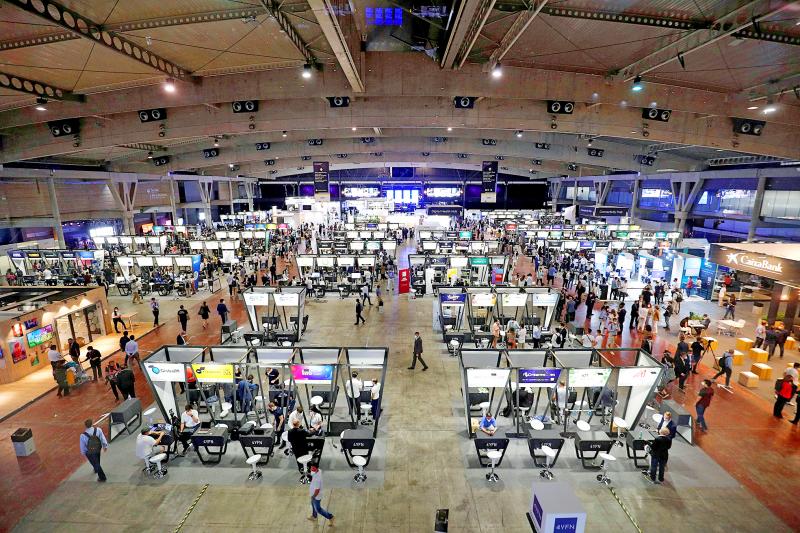Telecom bosses yesterday toasted the return of Barcelona’s Mobile World Congress with an agenda to put the industry at the center of digital development and inclusion in a global reboot following the COVID-19 pandemic.
Having kept networks humming while people were locked down at home, telecom executives said that the pandemic has shown how vital connectivity is to those with access to the latest technology, and more so for the billions who lack it.
Canceled last year at the last minute when COVID-19 first began to spread around the world, the annual event is being held in a hybrid format with about 30,000 visitors — rather than the 100,000 that typically attend — and others online.

Photo: Reuters
“We are back to business, back to Barcelona and back together,” said Mats Granryd, head of the GSMA industry association that hosts the biggest telecom get-together at the Fira de Barcelona trade show grounds.
With the acceleration of digitalization during the pandemic, cybersecurity and data governance are taking center stage, the heads of Telefonica SA, Deutsche Telekom AG and France’s Orange SA said, adding that building trust with consumers continues to be key.
“For too long progress in technology meant only advancement at any cost — but real progress comes when we move toward an equitable future, not when we just make shiny new things,” Orange CEO and GSMA chairman Stephane Richard said in a keynote address from the event’s main stage.
Saddled with high debt and weak revenues, telecoms are hoping to capitalize on the social credit derived from their role in connecting societies and individuals during the pandemic to position themselves as the “good guys.”
“Data cannot be extricated without compensation — it’s called digital dignity,” Telefonica CEO Jose-Maria Alvarez-Pallete said. “I have a right to know what my data is worth.”
The trio also called for an overhaul of regulation in the EU, saying that fragmentation across the bloc put them at a disadvantage against rivals, such as Facebook Inc’s WhatsApp messaging service.
“Connectivity today is needed, but in 2030, connectivity will be a human right,” Deutsche Telekom CEO Tim Hoettges said.
Most telecoms are betting big on 5G, with partnerships announced at the event spanning the cloud, software-as-a-service and traditional mobile and broadband operations.
Qualcomm Inc on Monday said that it expects to work with more than 30 carriers and telecommunications gear providers who have committed to using the faster variant of 5G networking technology.
Among them are China’s Fibocom Wireless Inc (廣和通) and China Unicom Ltd (中國聯通), Taiwan’s Chunghwa Telecom Co (中華電信), as well as Germany’s Deutsche Telekom and Australia’s Telstra Corp.
The fastest version of 5G uses higher frequencies and is called “millimeter wave” by Qualcomm, although different carriers brand it with their own trade names, such as Verizon Communications Inc’s “5G Ultra Wideband.”
Qualcomm’s chips have a lead in millimeter wave technology over rivals, such as MediaTek Inc (聯發科), so it could get a sales boost if the technology becomes more widely adopted.
“We actually haven’t seen a whole lot of millimeter wave outside the US and Japan, and some limited deployments in Europe and Korea so far, but that’s expanding quite rapidly,” Durga Malladi, Qualcomm’s senior vice president and general manager of 5G technologies, told a news press briefing.

The US dollar was trading at NT$29.7 at 10am today on the Taipei Foreign Exchange, as the New Taiwan dollar gained NT$1.364 from the previous close last week. The NT dollar continued to rise today, after surging 3.07 percent on Friday. After opening at NT$30.91, the NT dollar gained more than NT$1 in just 15 minutes, briefly passing the NT$30 mark. Before the US Department of the Treasury's semi-annual currency report came out, expectations that the NT dollar would keep rising were already building. The NT dollar on Friday closed at NT$31.064, up by NT$0.953 — a 3.07 percent single-day gain. Today,

‘SHORT TERM’: The local currency would likely remain strong in the near term, driven by anticipated US trade pressure, capital inflows and expectations of a US Fed rate cut The US dollar is expected to fall below NT$30 in the near term, as traders anticipate increased pressure from Washington for Taiwan to allow the New Taiwan dollar to appreciate, Cathay United Bank (國泰世華銀行) chief economist Lin Chi-chao (林啟超) said. Following a sharp drop in the greenback against the NT dollar on Friday, Lin told the Central News Agency that the local currency is likely to remain strong in the short term, driven in part by market psychology surrounding anticipated US policy pressure. On Friday, the US dollar fell NT$0.953, or 3.07 percent, closing at NT$31.064 — its lowest level since Jan.

The New Taiwan dollar and Taiwanese stocks surged on signs that trade tensions between the world’s top two economies might start easing and as US tech earnings boosted the outlook of the nation’s semiconductor exports. The NT dollar strengthened as much as 3.8 percent versus the US dollar to 30.815, the biggest intraday gain since January 2011, closing at NT$31.064. The benchmark TAIEX jumped 2.73 percent to outperform the region’s equity gauges. Outlook for global trade improved after China said it is assessing possible trade talks with the US, providing a boost for the nation’s currency and shares. As the NT dollar

The Financial Supervisory Commission (FSC) yesterday met with some of the nation’s largest insurance companies as a skyrocketing New Taiwan dollar piles pressure on their hundreds of billions of dollars in US bond investments. The commission has asked some life insurance firms, among the biggest Asian holders of US debt, to discuss how the rapidly strengthening NT dollar has impacted their operations, people familiar with the matter said. The meeting took place as the NT dollar jumped as much as 5 percent yesterday, its biggest intraday gain in more than three decades. The local currency surged as exporters rushed to